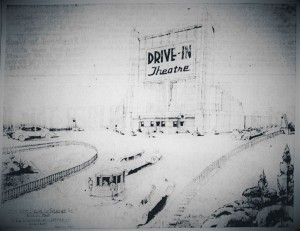This is the last installment about Indianapolis motion picture theaters. While the title may appear somewhat salacious suggesting the content deserves an “X-Rating,” the reader will find it nothing more than “PG” and most likely “G-Rated.” Sorry to disappoint; however younger readers may ask, “And what did you do when you went to the drive-in, granddad?”
Often on a summer evening in the 50s after supper, my dad would announce, “We’re going to the movies,” and my two brothers and I would race out to the car and scramble into the back seat. Mom and Dad would soon follow, and we would soon be off to the National Drive-In, east of Cumberland on U. S. 40 — the National Road. As we followed the other cars slowly past the ticket takers and into the vast parking area, I liked to gaze up at the large map of the United States painted on the street-side of the huge structure supporting the screen. U. S. 40 was marked as a great line across the multi-colored states from sea to sea. Once inside, my dad would negotiate a path among the other cars for a spot on sloping ground to park the car; roll down the window to a level where the speaker could be hung, and hope when it was turned on it would work! Sometimes a walk to the playground area was in order; it was exciting to be in the glow of the light projecting the moving images on the large screen.
The union of automobile and motion pictures was established when the first drive-in theater opened in 1933 in Camden, New Jersey. Seven years later this unique relationship came to Indianapolis when The Pendleton Pike became the first local drive-in theater. Developed by Midwest Drive-In Theaters, Inc. at a cost of $75,000 (2016: $1,304,349), the theater, originally known simply as the Drive-In Theater, was located near Ft. Benjamin Harrison at 9300 Pendleton Pike. When the drive-in opened at 7 p.m. on June 6, 1940, movie goers in five hundred cars, perched on eleven semi-circular graded ramps, enjoyed the outdoor experience of seeing Kay Kyser starring in That’s Right, You’re Wrong projected onto a 50 by 50 foot screen, the largest in the world, with the sound coming into each car through individual speakers. A Disney cartoon and selected shorts made up the first night’s showing. While cars were admitted FREE, each adult occupant paid a quarter (2016: $4.35) and each child occupant paid a dime (2016: $1.74).
In addition to movies, the Pendleton Pike Drive-In Theater served as a venue for Easter Sunrise Services and War Bond drives featuring jeeps, tanks, and amphibious vehicles. It also became “the only theater in the world with a playground” when swings, slides, rocking horses and a merry-go-round were installed at the beginning of the postwar years. Playgrounds — “kiddielands” — would become a feature of other Indianapolis drive-ins in the coming decade.
The Maywood Open Air (Bell-Air) Theater on Kentucky Avenue provided Indy moviegoers with a second drive-in experience when it opened in the waning days of World War II, and the West Side Outdoor Theater, 7301 W. Washington St, opened a year later. By the end of the decade, the Greenwood Drive-In Theater on South U. S. 31 and the Moonlite Drive-In Theater at U. S. 52 and State Road 9 offered movies under the stars for those who wanted to drive a little into the countryside.
The rapid development of outdoor theaters made the 1950s the Golden Age of this form of entertainment in Indianapolis. The Deluxe Drive-In Theatre in Clermont, the Maplecroft Auto Theater in Plainfield, the Meridian Drive-In Theatre on State Road 135, the Shadeland Outdoor Theatre, 2500 N. Shadeland, the Lafayette Road Outdoor Theatre, the National Outdoor Theater in Cumberland, and the Westlake Drive-In Theater provided moviegoers with additional convenient open air venues. On the Indianapolis southeast side at Rural and English Avenue, the Theatair Twin Drive-In Theatre (Twin-Aire), with its two screens, billed itself as “The World’s Largest” drive-in theater.
Not all Hoosiers looked with favor on drive-in theaters. Some proposed sites faced zoning opposition and during the 1951 session of the Indiana General Assembly, state Representative Herbert M. Copeland authored a bill which would prohibit drive-in theater patrons from taking liquor or beer with them. He termed drive-in theaters “passion pits” and said it is common for teenagers to sit in their cars and drink beer and whisky. Another representative and drive-in theater operator took exception to this characterization and termed drive-ins “family affairs.” One “drive-in theater” on the Indianapolis far east side was not a theater, but a restaurant. Al Green’s “Famous Food” opened in 1947 at East Washington Street and Shortridge Road. Known for its giant burgers, steak fries, and homemade creamy root beer, Al Green’s was a destination for nearly a decade before movies were added to the menu. With the installation of a screen, projection booth, and individual speakers, curb girls served teens, young adults, and families in several hundred cars a night while they watched a movie. This was a real drive-in theater experience; no getting out of your car to visit the concession stand.
One by one the old drive-in theaters closed, the acres of parking becoming weed filled gravel landscapes; the speakers rusting on their stands. The great structures supporting the giant screens crumbled; the screens sporting large pockmarks. And then it all vanished; the ground transformed into housing additions and business parks. Happily, however, not all are gone. The unique drive-in movie theater experience can still be found in Indianapolis; the Tibbs Drive-In Theatre continues a tradition that began in 1967 when it opens once again this month to offer movie-goers the enjoyment of sitting in the comfort of your automobile and viewing a movie on a GIANT screen.



